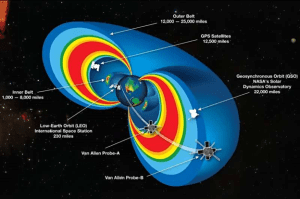TAG: GS 1: GEOGRAPHY, GS 3: SCIENCE AND TECHNOLOGY
THE CONTEXT: Scientists from the University of Alaska Fairbanks have made a groundbreaking discovery in the field of space physics by identifying a new type of electromagnetic wave, known as a “whistler,” which plays a significant role in transferring lightning energy to Earth’s magnetosphere.
EXPLANATION:
- This discovery offers critical insights into the complex interactions between Earth’s atmosphere and its magnetic field, with profound implications for both space exploration and satellite technology.
The Role of Whistlers in Earth’s Magnetosphere
- The newly identified wave, termed a “specularly reflected whistler,” is an electromagnetic wave that originates from lightning strikes.
- When lightning energy enters the ionosphere—a layer of Earth’s atmosphere rich in ions and free electrons—at low latitudes, it was previously assumed that this energy remained trapped within the ionosphere.
- However, the recent research challenges this assumption, revealing that a substantial portion of this energy is, in fact, transported to the magnetosphere.
Mechanism of the Specularly Reflected Whistler
- The ionosphere, which lies about 55 miles above Earth, plays a crucial role in this energy transfer.
- The specularly reflected whistler wave is reflected upward by the ionosphere’s lower boundary in the opposite hemisphere, effectively channeling the energy towards the magnetosphere.
- This process is distinct from what occurs at higher latitudes, where lightning energy reaches the magnetosphere through a different type of whistler wave known as the magnetospherically reflected whistler.
- The latter undergoes multiple reflections within the magnetosphere before dissipating.
Implications for Space Technology and Human Operations
- Understanding these waves is essential because Earth’s magnetosphere is a protective barrier that shields the planet from harmful solar wind particles.
- The radiation belts within the magnetosphere, however, are populated with highly energetic particles that can pose significant risks to satellites, spacecraft, and astronauts.
- By uncovering the dynamics of how lightning energy interacts with these belts, the findings could lead to better strategies for protecting space technology from radiation damage.
- The discovery is crucial for society’s reliance on space technology, as it offers new perspectives on the complex electromagnetic environment that surrounds our planet.
- Modern communication, navigation systems, and even human spaceflight depend on understanding and mitigating the risks posed by the radiation belts.

This graphic shows a cutaway model of Earth’s radiation belts with the two Van Allen Probes satellites flying through them
Research Methodology and Findings
- The discovery was made possible through the analysis of plasma wave data collected by NASA’s Van Allen Probes, which operated from 2012 to 2019, alongside lightning data from the World Wide Lightning Detection Network.
- The researchers developed a wave propagation model that included specularly reflected whistlers.
- It demonstrated that this type of wave significantly increases the amount of lightning energy reaching the magnetosphere—potentially doubling it compared to previous estimates.
- Their analysis confirmed that specularly reflected whistlers are not a rare phenomenon but a common occurrence within the magnetosphere.
- Given that the majority of lightning occurs at low latitudes, typically in tropical and subtropical regions, these findings suggest that specularly reflected whistlers may play a more substantial role in transferring energy to the magnetosphere than previously understood.
Broader Impact and Future Research
- This discovery builds on decades of research into the effects of lightning-generated whistler waves on radiation belt physics.
- Since the 1950s, scientists have recognized the importance of these waves in understanding and monitoring the plasma environment within Earth’s magnetosphere.
- The work not only enhances this understanding but also opens new avenues for research into how these waves can be used in remote sensing applications to study magnetospheric plasma.
- Supported by grants from the National Science Foundation and NASA EPSCoR, the findings represent a significant advancement in the field and underscore the importance of continued research into the Earth’s electromagnetic environment.
- As our reliance on space technology grows, so too does the need for a deeper understanding of the natural processes that can impact these technologies.
SOURCE: https://phys.org/news/2024-08-scientists-phenomenon-impacting-earth-belts.html#google_vignette
Spread the Word
